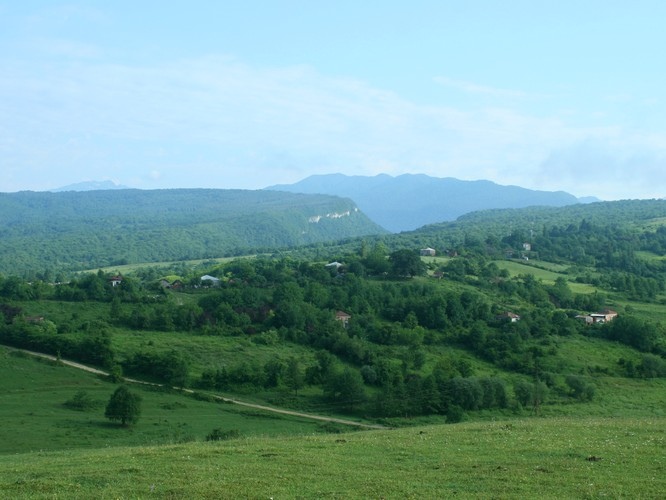
Tsebelda Valley. Part 1
The Military-Sukhum road, historically known as the Misimiyanskaya Road, or the Ancient Abkhaz Way, begins on the right shore of Machara (Madzhara) River in the Gulrypsh District on the outskirts of Sukhum. The modern road was built in the second half of the 19th century, during the Russo-Turkish War and the campaign to conquer the mountain tribes of the Caucasus. However, this road, which crosses the Caucasus Mountains at the Klukhor Pass, had connected the North Caucasus and Asia Minor for the previous five thousand years. During the "great migration period" (4th-7th centuries) this was one of the key routes from the Byzantine Empire to Central Asia bypassing the Caspian Sea. During the Soviet Era, the popular All-Union Tourist Route #43 passed along Sukhum Road.
Markhyaul Mineral Spring
We will begin our journey to the sights of the Kodori Gorge with the mineral spring in Markhyaul settlement (Markh'aul, or Merkheul in the Abkhaz language). The spring is located 3 kilometers away from a traffic police post on Kodori highway. The mild mineral water of the spring, which is similar to the Truskavets mineral water, is considered medicinal. The Markhyaul mineral spring is only about 30 minutes by car from the center of Sukhum.
Markhyaul, which lays on a trading route, was a sort of a caravan rest stop for centuries. In the late middle ages the settlement became part of the feudal domains of the Amarshan family. In 1867 and 1877 many Markhyaul residents were forcibly relocated to Turkey. In the late 19th century the population of the community increased significantly with the appearance of Georgian and Armenian settlers. Markhyaul is also known as the birthplace of Laverntii Beria, a well known political leader of the 20th century.
In the middle of Markhyaul (at the 8th kilometer) a road branches off to left, towards a picturesque restaurant in Chernigovka settlement. The restaurant sits amidst huge limestone boulders, around which runs the cool clear water of Right Madzharka.
Tibilium Fortress
After a tasty lunch of the local cuisine in Chernigovka, we will return to the main road and continue on to Tsebelda (Abkhaz: Tsabal). Homo sapiens have lived in this region for half a million years. Weapons from the Acheulean Period (1.6 million to 150,000 years ago) have been found on the neighboring mountains of Apiancha and Prtskha. In the first centuries of the common era, the local late ancient culture flourished in the region surrounding Tsebelda. The Tsebelda culture appeared under the direct influence of the ancient world. The originators of this culture were the Apsils, one of the key Abkhaz early-feudal peoples. Monuments in Tsebelda are a uniquely complete source for studying the weapons, military arts and decorations of the era of the Great Migration to the territories of the Caucasus, Middle Europe and Southern Europe.
In the Middle Ages, Apsilia was subject to repeated Arab invasions. To protect themselves, the Apsils erected major defensive structures. Among the largest monuments to defensive architecture are the ruins of a fortress mentioned in the writing of Byzantine scholar Procopius of Caesarea in the 6th century under the name Tibilium, or Tzibila. The fortress is located 4 kilometers away from the Tsebelda settlement, from which it takes its name. Built on a rocky cliff of the Adagua Mountains, with a 16-meter gate tower and walls that are 8 meters high and 2-3 meters thick, the fortress was unassailable. In the 7th and 8th centuries, the walls of the fortress repelled many attacks by Arabs. Inside the fortress there remained containers for collecting rainwater, the ruins of a small church, utility chambers and stone baptisteries. Burial chambers under the walls contained silver coins from the Roman era, metal weapons, hoes, ornaments from the 3-6th centuries and a bronze sarcophagus that is currently kept at the Hermitage Museum in St. Petersburg. Older artifacts have also been found in the area, including burial sites with numerous bracelets, necklaces and other objects from the last centuries before the common era, as well as graves from the end of the Bronze Age.
Voronov Manor "Yasochka"
Tsebelda settlement has another tourist attraction from a completely different period. If you turn right from the picturesque waterfall that is the source of the Madzharka River, in 2 kilometers you will arrive at the Yasochka Manor, the museum house of the Voronov family. The Voronovs were a famous dynasty of Abkhaz historians. N.I. Voronov, a well known public and cultural figure of Russia and Transcaucasia, moved here in the 1870s. N.I. Voronov was a member of the same academic movement as A.I. Gertsen and N.O. Ogarev. He headed the Caucasus department of the Russian Geographic Society and helped P. Uslar create an alphabet for the peoples of the Caucasus who did not have a written language; this included the first Abkhaz alphabet.
The story of the manor itself is also fascinating. The children of N.I. Voronov turned it into a workers' commune based on the ideas of Chernyshevsky. Later it was a safe house for Revolutionaries.












